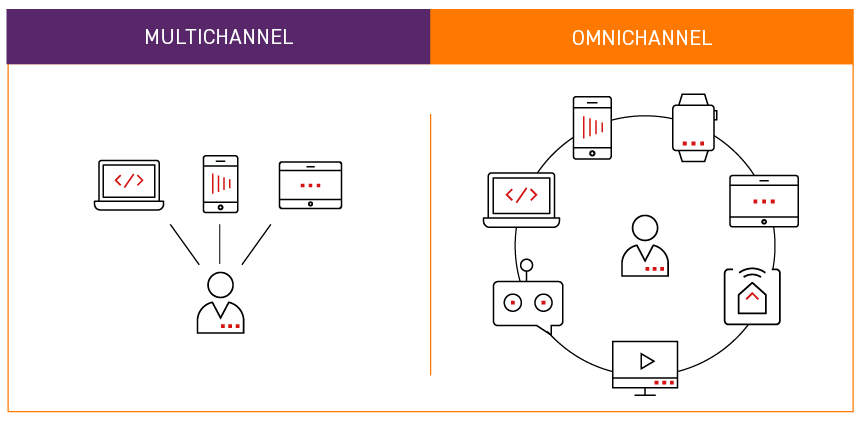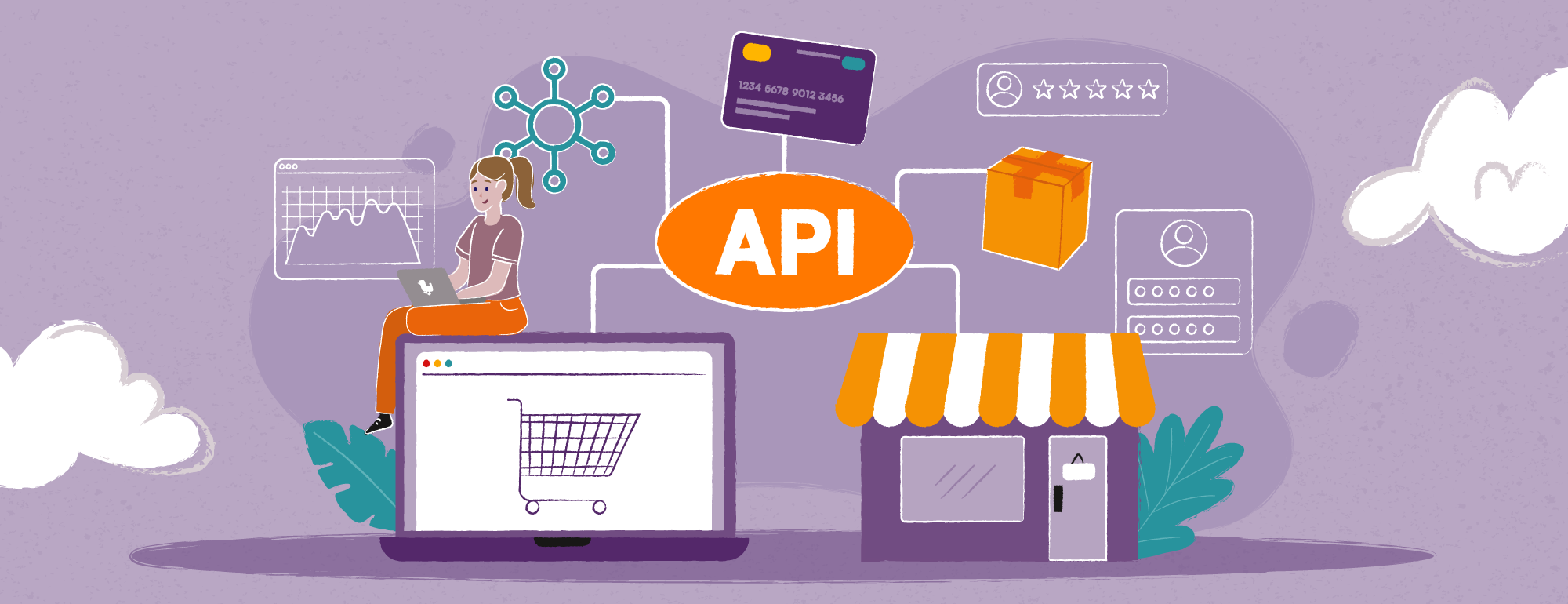E-commerce API / Unleashing the Full Potential of Online Business
Imagine a world where you could speak any language fluently – wouldn’t that be something? You could communicate with anyone, anywhere, opening up endless opportunities. In the digital and e-commerce world, APIs are the polyglots, that enable different software applications to talk to each other. In this blog post, we’ll explore the role of these digital linguists in the realm of e-commerce. Discover, how e-commerce API influences online business.
- What is API?
- Why are E-commerce APIs Important?
- 10 API Use Cases to Build and Support Your E-commerce Store
- E-commerce API and MACH approach
- Benefits of E-commerce API & MACH
- E-commerce API is an important building block for omnichannel
- How to Implement E-commerce APIs in Your E-commerce Business
What is API?
API, or Application Programming Interface, is in essence a set of rules and protocols that allow different software applications to communicate and exchange data. They ensure that everything runs smoothly behind the scenes, allowing different software applications to communicate and share data.
You can consider them to be the waiters in a restaurant. You ask the waiter (API) for your food, and he takes it to the kitchen (the server) and brings it back.
Why are E-commerce APIs Important?
API for e-commerce serve as crucial building blocks that enable a multitude of operations for online stores. They facilitate the seamless integration of various systems, creating a cohesive and efficient digital ecosystem.
How do E-commerce APIs facilitate online business?
- E-commerce APIs allow your platform to interact with payment gateways, ensuring secure and efficient transactions.
- APIs connect your platform with inventory management systems, enabling real-time updates of stock levels.
- APIs for e-commerce link your customer relationship management software, allowing personalized interactions based on collected customer data and customer attributes.
- APIs empower e-commerce businesses to extend their reach beyond their own e-commerce platforms. They enable integration with external marketplaces, social media platforms, and comparison shopping engines, thereby expanding the potential customer base.
In short, APIs are the backbone of modern e-commerce operations, enabling interoperability between diverse systems and facilitating a multitude of functionalities that enhance both the customer experience and business efficiency.
10 API Use Cases to Build and Support Your E-commerce Store
A typical e-commerce doesn’t operate in isolation but requires a harmonious blend of multiple systems. It’s more like the hub of a massive wheel, with numerous spokes connecting it to various functionalities.
E-commerce APIs are widely used to connect these various systems and functionalities. As you’ll see, e-commerce APIs bring a wide variety of applications in many areas of e-commerce businesses.
1. Payment Gateway
Payment APIs connect e-commerce platforms with payment gateways, facilitating secure and efficient transactions.
2. Product Information Management (PIM)
APIs allow for the seamless exchange of product information between the e-commerce platform and the PIM system, ensuring accurate and up-to-date product details.
3. Content Management System (CMS)
APIs link the e-commerce platform with the CMS, enabling the efficient management and delivery of digital content.
4. Order Management System (OMS)
APIs facilitate the flow of order information between the e-commerce platform and the OMS, ensuring efficient order processing and fulfillment.
5. Warehouse Management System (WMS)
E-commerce APIs enable real-time communication between the e-commerce platform and the WMS, ensuring accurate inventory management.
6. Point of Sale (POS) Systems
APIs connect online and offline sales channels, enabling a seamless omnichannel retail experience.
7. Tax Calculation Systems
Given the complex and varied tax regulations worldwide, API automatically calculate the correct tax amount based on customer location and product type.
8. Review services
Customer reviews can significantly influence purchasing decisions. Integrating an API that facilitates reviews can enhance product trustworthiness and improve organic search rankings.
9. Social Media Platforms
APIs allow you to connect your store to social platforms for advertising, showcasing products, or even enabling social logins for easier user account creation.
10. Shipping Providers Systems
With API you can automate shipping rate calculation, print labels, and provide real-time tracking information to your customers, enhancing the post-purchase experience
As businesses scale and customer expectations evolve, the number of integrated external systems can easily reach double digits, making seamless integration not just a luxury but a necessity for success in the competitive e-commerce space.

E-commerce API and MACH approach
The approach to IT architecture that leverages the power of e-commerce APIs and enable a more flexible, scalable, and efficient e-commerce businesses is MACH.
MACH is an acronym for Microservices based, API-first, Cloud-native, and Headless. It represents a significant shift in the way e-commerce platforms are designed and operated.
M for Microservices
Microservices-based architecture allows for the development of modular functionalities that can operate independently which make it easier for updates and maintenance. Changes to one microservices do not impact the others.
A for API
API-first design, a key component of MACH architecture, puts APIs at the forefront of software development. This approach ensures that systems are built for integration and interoperability from the ground up, facilitating seamless communication between different software applications.
C for Cloud
Then we have Cloud-native, which provides great flexibility in delivering content across multiple channels, especially during hot season like for example, Christmas or Black Friday.
H for Headless
And finally, Headless architecture separates the frontend presentation layer from the back-end logic and functionality. This supports e-commerce data consistency across channels and quick front-end changes without disrupting the backend.
Companies that have adopted MACH architecture, such as Amazon and Netflix, have demonstrated its potential in driving online businesses growth and innovation. By leveraging the power of APIs, these companies have created flexible, scalable, and resilient e-commerce websites that can adapt quickly to changing market dynamics and customer preferences.
This shift towards MACH architecture underscores the critical role of e-commerce APIs in shaping the future of e-commerce business.
What are the other crucial benefits of e-commerce APIs?

Benefits of E-commerce API & MACH
In the complex world of e-commerce industry, a multitude of systems and channels need to work in harmony to deliver a seamless shopping experience. The synergy between E-commerce APIs and MACH architecture offers a plethora of advantages for modern e-commerce businesses.
Seamless Integration
E-commerce APIs ensure smooth data flow between various systems, from payment gateways to inventory management.
Real-time Updates
APIs facilitate instantaneous updates, ensuring accurate product listings, stock levels, and pricing.
Scalability
MACH’s microservices-based structure allows businesses to grow and adapt without extensive system overhauls.
Resilience & Flexibility
Being cloud-native, MACH ensures high availability, reducing downtimes and enhancing user experience.
Tailored Experiences
The headless component of MACH allows businesses to customize user experiences across different channels, from web to mobile to in-store kiosks.
Cost Efficiency
With modular components and cloud-native operations, businesses can optimize resources, leading to reduced operational costs.
Rapid Innovation
The API-first approach of MACH empowers businesses to quickly integrate new features, tools, or platforms, staying ahead of market trends.
Together, these benefits position businesses to effectively navigate the complexities of the digital marketplace and – constantly evolving customers’ needs.
E-commerce API is an Important Building Block for Omnichannel
Nowadays, customers interact with brands through multiple channels – online, in-store, mobile apps, social media, and more. They expect a consistent and seamless customer experience across all touchpoints, not only e-commerce websites. We call it the omnichannel model. And APIs enable an omnichannel approach by connecting these different channels in one consistent shopping experience.

Moreover, APIs also facilitate a multiexperience strategy. They allow e-commerce businesses to tailor the customer experience to the specific strengths and characteristics of each channel. For instance, the mobile app experience can be optimized for convenience and speed, while the in-store experience can be designed to provide personalized service and tactile product interactions.
As you can see, API in e-commerce enable the integration of various systems and channels, facilitating a seamless, consistent, and personalized shopping experience. As e-commerce continues to evolve, the role of APIs in connecting the dots will become even more critical.

How to Implement E-commerce APIs in Your E-commerce Business
Now that you are familiar with all the benefits of using e-commerce APIs, you’d probably like to know how to start implementing e-commerce APIs in your online business. Especially if you are stuck in a monolithic platform.
Is there a way to smoothly transition your e-commerce business to a scalable and API-based architecture? As with any major change, integrating e-commerce APIs into your entire e-commerce site, ecosystem, and business logic can be challenging. However, there’s a way to do it with a strategic approach followed by careful planning and execution.
What factors you need to consider?
Understand your key systems
We don’t recommend jumping in and picking the technology to implement. The first step in making e-commerce APIs work for you is to map out your current software architecture: What systems do you currently have? How are they connected? How do they communicate with each other? What databases do you have? Do your systems already use APIs? What types of APIs are they? This thorough as-is analysis will help you decide whether it’s worth changing and adapting your IT architecture. Or would it be better to build everything from the ground up?
If you do decide to modify your current architecture to accommodate e-commerce APIs, you will also need to assess how much effort it will take to prepare your infrastructure to do so.
Determine which systems to start with
Let’s say you have decided to modify your current e-commerce platform. It’s time to plan and decide which systems to change first. General advice is to start with the least problematic ones. Changing the checkout may not be the best first choice, as many systems overlap there. Start with something simpler (and you’d probably know what is it after as-is analysis ;-)) – maybe login panel or PIM integration?
Decide how to handle frontend applications
Transitioning your e-commerce ecosystem to an API approach requires some decision regarding the frontend. Is it better to update an existing frontend layer or create a new one? Is it better to create one frontend layer or create separate frontends for mobile, website, customer login panel, etc.? There’s no single answer to this question, as it all depends on the existing architecture and your goals.
Consider infrastructure
The whole transition process is also the moment to reconsider your current infrastructure and maybe switch to the cloud and ready components delivered by cloud providers. You don’t have to move to cloud all infrastructure at once, you can move on at your pace and step by step reduce the number of hardware servers.
Building new services alongside existing features
Now let’s explain the general process of decomposing your monolithic architecture into flexible microservices. This is a good moment to change the technology for the newer one, as you don’t have to stick to the previous solution anymore.
Imagine you want to replace the old payment gateway with the new solution. What you (or your IT provider) need to do is build a parallel microservices-based solution, and when it’s ready, turn off the old one and turn on the new one.
This is a bit of a simplification for this article, as we would rather not overwhelm you with dozens of technical issues that need to be considered in the implementation phase. 😉 Then you can repeat the above process with other features and services, breaking down your monolith step by step.

One of the most critical and important factors in the whole process is ensuring business continuity. No company wants to shut down the online store or cause problems with the shopping experience. You need to confirm that your team or partner is capable of running the decomposition process smoothly.
API Hold E-Commerce System Together
In the grand scheme of things, APIs might seem like a small cog in the wheel. But as you’ve seen, this small, invisible cog plays a crucial role in driving the entire machinery of e-commerce operations.
E-commerce APIs connect various systems, facilitate seamless interactions, and ultimately, create a cohesive and efficient digital ecosystem. Embracing APIs is not just an option, but a strategic imperative for e-commerce businesses seeking to thrive in the digital age.







